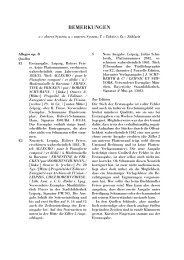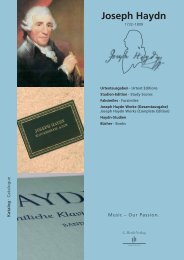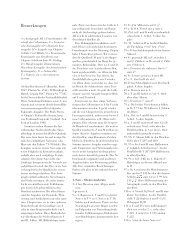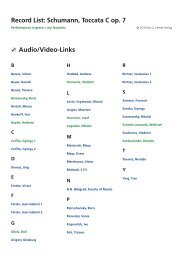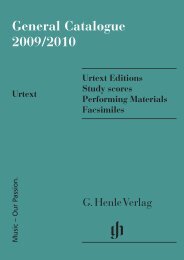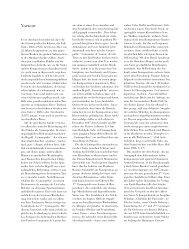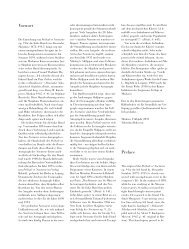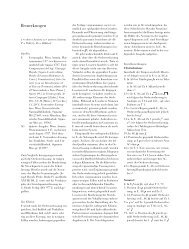Bemerkungen Co
Bemerkungen Co
Bemerkungen Co
Create successful ePaper yourself
Turn your PDF publications into a flip-book with our unique Google optimized e-Paper software.
14<br />
<strong>Bemerkungen</strong><br />
T = Takt(e)<br />
Quellen<br />
AL Autograph. London, British Library,<br />
Signatur: Add. Ms. 17831<br />
(Konvolut mit weiteren Handschriften<br />
Dragonettis). Titel von<br />
Vincent Novellos Hand: Twelve<br />
Waltzes. Sechs Seiten Notentext<br />
(fol. 2r –4v ) mit je zwei Walzern.<br />
Zahlreiche Korrekturen (Auskratzungen),<br />
Änderungen und<br />
Ergänzungen. Von Novello umfangreiche<br />
Anmerkungen auf<br />
fol. 2r oben, unten sowie an beiden<br />
Rändern: These extraordinary<br />
specimens of the ‘Waltz style’<br />
as applied to the capabilities<br />
of such an instrument as the<br />
double bass were some of the last<br />
‘playful Exercises’ which Dragonetti<br />
wrote to service his wonderful<br />
command over that gigantic<br />
instrument. Die Walzer sind fortlaufend<br />
nummeriert, daneben ist<br />
auch eine abweichende Zählung<br />
(1, 2, 5, 11, 12, 6, 7, 3, 4, 9, 10,<br />
8) erkennbar, die weder der<br />
Hand Dragonettis noch derjenigen<br />
Novellos eindeutig zuordbar<br />
ist.<br />
AP Autograph von Nr. 10. Paris, Bibliothèque<br />
nationale de France,<br />
Signatur: W. 2L. G. Kein Titel,<br />
Tempobezeichnung: Allegretto.<br />
Geänderte und vor allem um Dynamikzeichen<br />
ergänzte autographe<br />
Abschrift nach AL , fol. 4r .<br />
Eine Seite Notentext mit separatem<br />
Widmungsblatt: Souvenire<br />
del Sig[no]r Domenico Dragonetti,<br />
| Per il suo amico Sig[no]r<br />
Barré | Per presentare al suo<br />
amico il Sig[no]r Albeneck | <strong>Co</strong>n i<br />
comprimenti del sudetto Dragon.<br />
Zur Edition<br />
Hauptquelle ist AL bis auf Nr. 10, wo AP als spätere autorisierte Quelle unserer<br />
Edition zu Grunde gelegt wird. Offensichtliche<br />
Vorzeichenfehler wurden still-<br />
schweigend korrigiert. Anderweitige Ergänzungen<br />
des Herausgebers (z.B. nicht<br />
eindeutige Akzidenzien, Artikulationsvorschläge<br />
und Bindebögen) stehen ausnahmslos<br />
in Klammern. An Parallelstellen<br />
wurde nicht angeglichen, da subtile<br />
Unterschiede möglicherweise beabsichtigt<br />
sind. Bei Akzentzeichen ist in den<br />
Quellen eine Abgrenzung zu (kurzen)<br />
diminuendo-Gabeln nicht immer möglich;<br />
in Zweifelsfällen wurde Akzent<br />
ediert. Einige Verzierungszeichen wurden<br />
nur flüchtig notiert und sind daher<br />
nicht eindeutig identifizierbar. So<br />
scheint Dragonetti ein dem heutigen<br />
Mordent ähnelndes Zeichen Q zu benutzen,<br />
das wohl als Pralltriller e zu<br />
interpretieren ist und als solcher ediert<br />
wurde. Die wenig systematische Verwendung<br />
der Fortsetzungsstriche nach<br />
cresc. wurde unverändert übernommen.<br />
Auf die Wiedergabe von Triolengruppenbögen<br />
wurde verzichtet. Fehlende<br />
Bindebögen zwischen Vorschlags-<br />
und Hauptnote wurden ergänzt und orthographische<br />
Besonderheiten stillschweigend<br />
modernisiert. Falls nicht<br />
anders vermerkt, beziehen sich die folgenden<br />
Lesarten jeweils auf die Hauptquelle.<br />
Lesarten<br />
Nr. 1<br />
5: Bogen wohl aus Platzgründen nach<br />
2. Note neu angesetzt.<br />
13–15: Bogen jeweils über den ganzen<br />
Takt.<br />
23: Erkennbarer Bogen über ganzem<br />
Takt gehört zu einer älteren Lesart.<br />
Staccato-Punkte wurden später ergänzt<br />
und dabei Bogen wohl irrtümlich<br />
nicht angepasst.<br />
31: Ende des Bogens nicht eindeutig,<br />
evtl. bis 3. Note.<br />
Nr. 2<br />
26 f. und 30 f.: Bogen jeweils über den<br />
ganzen Takt.<br />
39: Lesart mit Doppelgriff g/h nicht eindeutig,<br />
g evtl. später wieder gestrichen.<br />
Nr. 3<br />
Auftakt zu 5: Bogen bis Ende T 5 zusätzlich<br />
zu Zweierbindungen. An<br />
Parallelstelle T 21 zunächst nur Bogen<br />
h–d 1 , später zu der wiedergegebenen<br />
Lesart mit Bogen ab Auftakt<br />
(c–d 1 ) geändert; T 5 wurde entsprechend<br />
angeglichen.<br />
32: Ursprünglich p, später in f geändert<br />
und p wohl irrtümlich nicht getilgt.<br />
Nr. 4<br />
41 f.: Zweierbindung, an T 49 f. angeglichen.<br />
Nr. 5<br />
27: Beginn des Bogens nicht eindeutig,<br />
evtl. erst ab 2. Note.<br />
Nr. 6<br />
24, 28: f steht erst am Taktende bzw.<br />
nach Zeilenwechsel vor nächstem<br />
Takt.<br />
29: Bindung nur für c , an T 25 angepasst.<br />
33: Auf 2. a wohl irrtümlich Staccato-<br />
Punkt.<br />
Nr. 8<br />
28 f.: Bogen über Taktstrich beginnt<br />
wohl versehentlich eine Note früher.<br />
Nr. 9<br />
31: Hinsichtlich Tonhöhen und Notenwerten<br />
gültige Lesart bis Fine nicht<br />
identifizierbar. Möglicherweise (im<br />
Da capo?) nur s Oktavsprung f 1 –f<br />
gemeint.<br />
Auftakt zu 32: Hier Widmung, die sich<br />
offenbar nur auf das Trio bezieht<br />
(wegen der ungewöhnlichen Takte<br />
40 ff.?): Souvenire per il Sig[no]r Masonis,<br />
& Sig[no]r Joan Alberto Ruciz<br />
<strong>Co</strong>sta.<br />
Nr. 10<br />
Edition nach AP als „Fassung letzter<br />
Hand“.<br />
15: Dynamikangabe nicht eindeutig (fr?),<br />
möglicherweise rinforzando (rf) gemeint.<br />
In AL folgende ältere Lesarten:<br />
Tempobezeichnung Allegro, kleinere Divergenzen<br />
bezüglich Dynamik und Bindebögen;<br />
es fehlen die Worte Trio und<br />
senza replica.<br />
13 f.: Takte fehlen ursprünglich, wur-
den dann über der Notenzeile nachgetragen.<br />
20: a A statt v<br />
Nr. 12<br />
4: f wohl nur aus Platzmangel erst unter<br />
4. Note.<br />
8: Neben Auftakt-a g auch ältere Lesart<br />
c g, die wohl nicht mehr gilt<br />
(gleichzeitige Ausführung beider Lesarten<br />
als Doppelgriff mit leerer Saite<br />
unwahrscheinlich).<br />
9: Bei 5. Note auch andere Lesarten<br />
möglich: g bzw. Doppelgriff g/c 1 .<br />
32 f.: Zwischen beiden Takten ursprünglich<br />
ein weiterer Takt, später<br />
von Dragonetti (?) mehrfach durchgestrichen.<br />
Vor 1. Note T 33 Vorschlag<br />
in nicht erkennbarer Tonhöhe;<br />
wurde vermutlich nicht mit getilgt.<br />
Dresden, Frühjahr 2007<br />
Tobias Glöckler<br />
<strong>Co</strong>mments<br />
M = measure(s)<br />
Sources<br />
AL Autograph. London, British Library,<br />
shelfmark: Add. Ms.<br />
17831 (a miscellany also containing<br />
manuscripts of other<br />
Dragonetti works). The title<br />
Twelve Waltzes is written in the<br />
hand of Vincent Novello. There<br />
are six pages of music (f. 2r –4v ),<br />
each containing two waltzes. Numerous<br />
corrections (scratchings<br />
A P<br />
out), changes and additions. Extensive<br />
remarks by Novello at the<br />
top and bottom of f. 2r , as well as<br />
in both margins: These extraordinary<br />
specimens of the ‘Waltz<br />
Style’ as applied to the capabilities<br />
of such an instrument as the<br />
double bass were some of the last<br />
‘playful Exercises’ which Dragonetti<br />
wrote to service his wonderful<br />
command over that gigantic<br />
instrument. The waltzes are<br />
numbered sequentially, but a different<br />
numbering (1, 2, 5, 11,<br />
12, 6, 7, 3, 4, 9, 10, 8) is also<br />
visible. This numbering cannot<br />
definitely be attributed either to<br />
Dragonetti’s or Novello’s hand.<br />
Autograph of No. 10. Paris, Bibliothèque<br />
nationale de France,<br />
shelfmark: W. 2L. G. There is no<br />
title, the tempo marking is: Allegretto.<br />
It is an altered autograph<br />
copy of AL, f. 4r , principally with<br />
additional dynamic markings.<br />
One page of music, plus a separate<br />
dedication page: Souvenire<br />
del Sig[no]r Domenico Dragonetti,|<br />
Per il suo amico Sig[no]r Barré<br />
| Per presentare al suo amico il<br />
Sig[no]r Albeneck | <strong>Co</strong>n i comprimenti<br />
del sudetto Dragon.<br />
Notes on the edition<br />
The main source is AL except for<br />
No. 10, where AP , being a later authorized<br />
source, has been used as the basis<br />
for this edition. Obviously missing accidentals<br />
have been corrected silently, but<br />
without exception, all other editorial<br />
additions (e. g. unclear accidentals, proposals<br />
concerning articulation and<br />
slurs) appear in parentheses. Parallel<br />
passages have not been rendered consistent,<br />
since it is possible that subtle<br />
differences between them were intended.<br />
It is not always possible to distinguish<br />
accent signs from (short) diminuendo<br />
hairpins; in case of doubt, accent<br />
signs were edited. Some signs for ornaments<br />
were only cursorily notated, and<br />
are therefore not clearly identifiable.<br />
Dragonetti seems to use a sign Q which<br />
is similar to the modern mordent sign<br />
but should rather be interpreted as an<br />
15<br />
inverted mordent e and was edited as<br />
such. The continuation strokes after<br />
cresc.-markings, rarely systematic, have<br />
been adopted without alteration. Slurs<br />
indicating triplet groups have been deleted.<br />
Missing slurs between appoggiaturas<br />
and principal notes have been added,<br />
and orthographic idiosyncrasies silently<br />
modernized. Unless otherwise<br />
noted, the following readings relate to<br />
the main source.<br />
Readings<br />
No. 1<br />
5: Probably for reasons of space, the<br />
slur is restarted after the 2nd note.<br />
13–15: Each bar is covered by a slur<br />
over 9 notes.<br />
23: The slur visible over this whole<br />
measure belongs to an older reading.<br />
Staccato dots were added later, the<br />
slur was not adapted to take account<br />
of them, surely by mistake.<br />
31: The end of the slur is unclear; maybe<br />
extends to 3rd note.<br />
No. 2<br />
26 f. and 30 f.: Each bar is covered by a<br />
slur over 9 notes.<br />
39: Reading with double stop g/b is unclear:<br />
it is possible that the g was later<br />
deleted.<br />
No. 3<br />
Upbeat to 5: Slur to end of M 5 additionally<br />
to the slurs of 2 notes. Parallel<br />
place M 21 first had only a slur<br />
b–d1 , which was later changed to the<br />
reading reproduced here, i.e. a slur<br />
from upbeat (c–d1 ); M 5 was<br />
changed for consistency.<br />
32: Originally p, later changed to f, but<br />
p not deleted, surely by mistake.<br />
No. 4<br />
41 f.: The slur over 2 notes was adapted<br />
to accord with M 49 f.<br />
No. 5<br />
27: Beginning of slur is unclear; possibly<br />
starts only on 2nd note.<br />
No. 6<br />
24, 28: f appears only at the end of the
16<br />
measure, or after the change in stave<br />
before the next measure, respectively.<br />
29: Slur only for c , adapted to accord<br />
with M 25.<br />
33: Staccato dot on 2 nd a , surely by error.<br />
No. 8<br />
28 f.: Slur over the barline begins one<br />
note earlier, probably by mistake.<br />
No. 9<br />
31: A valid reading of pitches and note<br />
values up to Fine cannot be clearly<br />
identified. Perhaps (in the Da Capo?)<br />
only an s octave leap f 1 –f is<br />
meant.<br />
Upbeat to 32: A dedication appears<br />
here, obviously meant to apply only<br />
to the Trio (on account of the unusual<br />
measures from M 40 ff.?): Souvenire<br />
per il Sig[no]r Masonis, & Sig[no]r<br />
Joan Alberto Ruciz <strong>Co</strong>sta.<br />
No. 10<br />
Edited in accordance with AP as the<br />
“latest authorised version”.<br />
15: Dynamic marking is unclear (fr?),<br />
possibly rinforzando (rf) is meant.<br />
In AL the following older readings appear:<br />
Tempo marking Allegro, with small differences<br />
in respect of dynamics and<br />
slurs; the words Trio and senza replica<br />
are not present.<br />
13 f.: These measures were originally<br />
missing, but were subsequently added<br />
below the stave.<br />
20: a A instead of v<br />
No. 12<br />
4: f delayed to 4th note, probably solely<br />
for reasons of space.<br />
8: Next to the upbeat a g there is also<br />
an older reading c g, surely no<br />
longer applicable (simultaneous performance<br />
of both readings as a double<br />
stop with the open string is unlikely).<br />
9: Other readings of the 5th note are<br />
possible: g or double stop g/c1 .<br />
32 f.: There was originally another<br />
measure between these two measures,<br />
but it was later crossed out several<br />
times (by Dragonetti?). A grace note<br />
of unidentifiable pitch precedes the<br />
1st note of M 33: it was probably not<br />
cancelled.<br />
Dresden, spring 2007<br />
Tobias Glöckler



